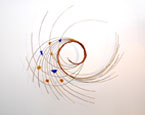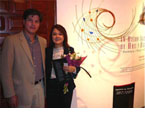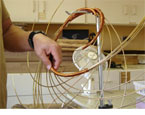|
|
|||||||||||
| home | History | exhibitions | projects | gallery | analysis | links | contact | blog | |||||||||||
|
|
 |
 |
|||||||||
|
PROJECTS
|
|
||||||||||
|
Project |
|
||||||||||
|
The Work´s Theme” After an analysis of the possibilities of combining the themes and techniques that both artists have been developing, the idea came up to use the leadwork “structure” in Rosemary´s work with the spiral geometry which Alonso has been studying for some time. Besides, this combination adapted itself perfectly to the “textile” concept Rosemary has given her work and the idea of natural growth represented by Fibonacci´s spiral. With this theme they found the ideal combination between a mathematical structure in Alonso´s work and the textile characteristic of Rosemary´s project. The name Fibonacci´s Spiral was denominated in honor to the 13th century Italian mathematician Leonardo de Pisa (Fibonacci), who defined the succession that carries his name, Fibonacci´s Succession (1, 1, 2, 3, 5, 8, 13, etc.), in which each element is the sum of the two previous numbers. It is a simple succession but has very interesting qualities. The most recognized aspect is that the relation between two consecutive elements tends towards the well-known constant, Fi (F) = 1.618034 . . . This relation is known in the arts as the aureate proportion, or golden number. If a spiral has a growth radius equivalent to Fi, the result is the logarithmic spiral or natural spiral, also known as the Fibonacci´s spiral. The proportion of growth of this spiral is very frequent in nature. It coincides with the form of growth of certain species of snails and some inflorescences (for example, the distribution of seeds in the sunflower or in pine-trees). In the process of the plants´ growth (phyllotaxis), it is possible to recognize the Fibonacci sequence in the number of leaves produced by the stem. The theme was appropriate not only due to the fusion of the works of both artists; it also reflected the symbolism of an artistic idea going through the processes of gestation, growth and development. The work emerged naturally, as the meeting of two artistic minds, just like the fallen seed that germinates, unfolds and develops in space, following the lines of nature until its culmination, spreading out like a flower or a plant cluster closing their natural cycles of life.
-The Making of the Work |
||||||||||



